NEWS
National Gallery of Bulgaria Hosts Exhibition of Himalayan Buddhist Art
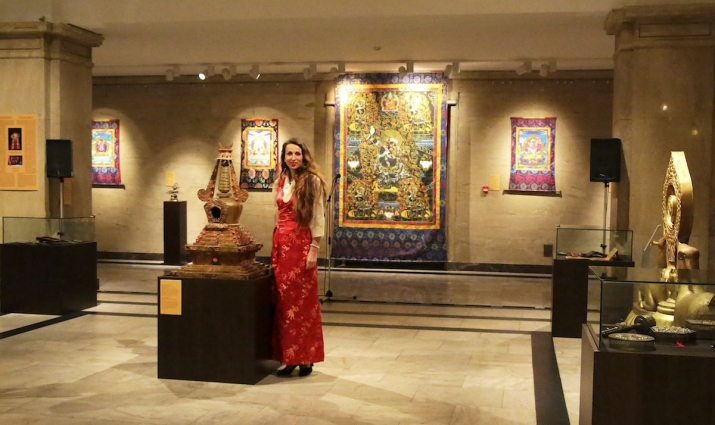 The author and curator of the exhibition in the exhibition hall. Image courtesy of Todor Mitov
The author and curator of the exhibition in the exhibition hall. Image courtesy of Todor MitovSOFIA—A unique exhibition of Buddhist art from the Himalayas has opened at the National Gallery of Bulgaria comprising of works from the National Gallery’s own collection, along with exhibits from the Historical Museum – Dimitrovgrad and the private collections of photographer and writer Nikolay Genov and painter Dr. Lyudmil Veselinov.
The exhibition charts an exciting journey through the mystical worlds of the Himalayas and acquaints the visitor with images of enlightenment that have the power to awaken the human spirit. Works at the National Gallery include statues from India, Mongolia, and Tibet, while the Historical Museum – Dimitrovgrad presents part of its collection of Tibetan art donated in 2011 by the then-ambassador extraordinary and plenipotentiary of the People’s Republic of China to Bulgaria. Artifacts from the collections of Nikolay Genov and Dr. Lyudmil Veselinov include Buddhist icons, ritual objects, and illustrated manuscripts from Mongolia and Tibet. The exposition also includes photographs by Teodor Malchiev in Bhutan, India, Nepal, and Tibet.
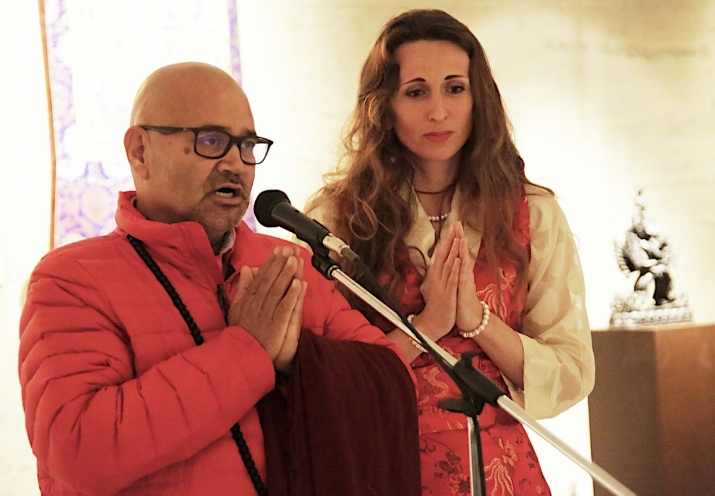 Khenpo Ramesh Negi performs Buddhist prayers during the opening of the exhibition. Image courtesy of Todor Mitov
Khenpo Ramesh Negi performs Buddhist prayers during the opening of the exhibition. Image courtesy of Todor Mitov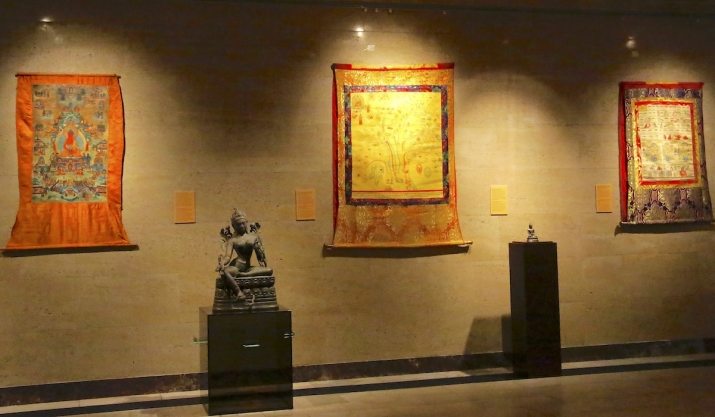 Statues of Green Tara and Shakyamuni Buddha along with a thangka of Amitabha Buddha and two medical thangkas. Image courtesy of Todor Mitov
Statues of Green Tara and Shakyamuni Buddha along with a thangka of Amitabha Buddha and two medical thangkas. Image courtesy of Todor MitovBuddhist art is a remarkable expression of the cultures that have developed over the centuries in and around the Himalayan mountain range that incorporates the Tibetan Plateau, Nepal, Bhutan, and the northern reaches of India and Pakistan. Neighboring geographic areas, such as China, Buryatia, Mongolia, southern Siberia, Tuva, and northern Myanmar, also bear the influences of Himalayan culture.
The Buddhist art of the Himalayas is characterized by expressly religious themes, combining influences from neighboring regions with unique compositions, symbols and motifs. This sacred art bears the marks of the Mahayana and Vajrayana Buddhist traditions, recreating their characteristic themes and artistic styles and all bearing a profound sacral significance. The religious and philosophical concepts of these two schools are reflected in the paintings, sculptures, architecture, and ritual objects and are typified in murals in temples and monasteries, as illustrations in religious manuscripts, medical and astrological treatises, and as icons with deeply religious meaning, known in Tibetan as thangkas.
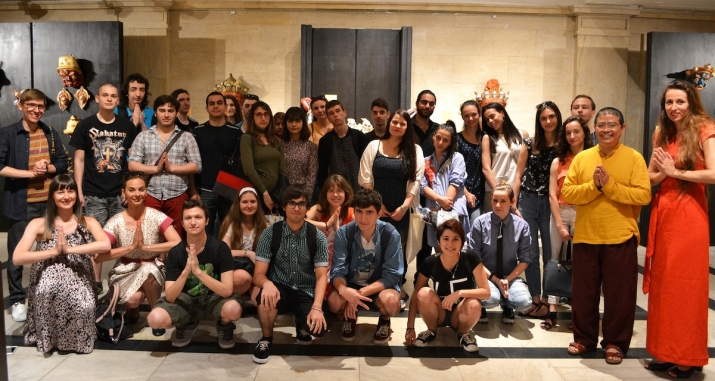 Students from the University of Sofia “St. Kliment Ohridski” with Pema Rinpoche. Image courtesy of Desislava Vaseva
Students from the University of Sofia “St. Kliment Ohridski” with Pema Rinpoche. Image courtesy of Desislava Vaseva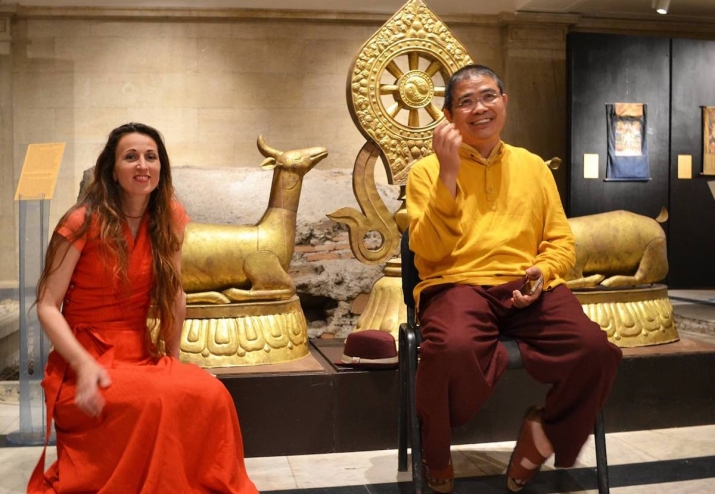 Pema Rinpoche gives a lecture in the exhibition hall. Image courtesy of Desislava Vaseva
Pema Rinpoche gives a lecture in the exhibition hall. Image courtesy of Desislava VasevaSeveral events were organized during the first week after the opening of the exhibition on 8 June, including a lecture by Khenpo Ramesh Negi, a Tibetan lama from the Drukpa Kagyu tradition and director of the Buddhist Tradition Kampagar Bulgaria religious instituition. During his talk he explained the secret meanings of the images depicted on the thangkas and the symbolism of their colors. Khenpo Ramesh also participated in the opening of the exhibition, performing prayers in Pali, Sanskrit, and Tibetan.
Another Tibetan lama, Pema Rinpoche, a teacher from the Palyul tradition of Nyingma School and the founder and director of the Palyul Center Bulgaria, gave a talk on love and compassion in Buddhism for students from the University of Sofia “St. Kliment Ohridski” who attended the exhibition. In addition to the students, who are studying courses on the religions and spiritual traditions of Asia and women in Buddhism, were several groups of children who explored the Buddhist art of Himalayas and created their own paintings, influenced by the exposition.
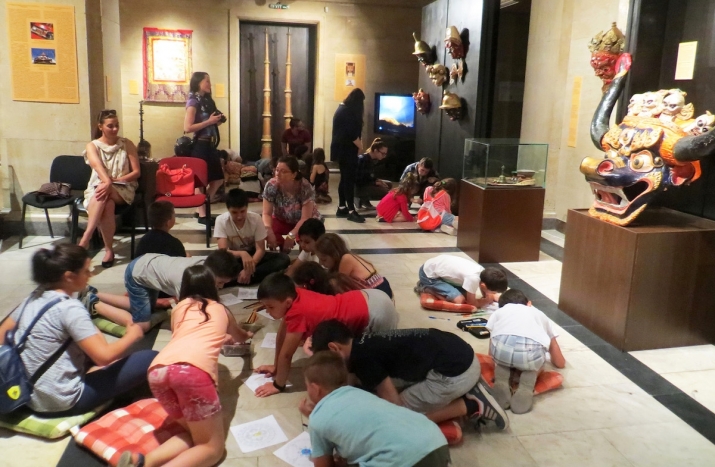 Children create paintings inspired by Buddhist art. Image courtesy of the author
Children create paintings inspired by Buddhist art. Image courtesy of the authorIt was a great honor for me to be a curator for this special event, presented in Bulgaria for the first time. The exhibition can be viewed at the National Gallery until mid-September 2017.
Related news from Buddhistdoor Global
San Antonio Museum of Art Examines Salvation and Retribution in Pure Land Buddhism
Archaeologists in China Recover Over 1,500 Buddhist Artifacts from Temple Lost 1,000 Years Ago
Exquisite Ancient Buddha Image from Mes Aynak to be Exhibited at National Museum of Afghanistan
Related features from Buddhistdoor Global
Along the Path of the Buddha: Buddhism in Bulgaria
Connecting Art, Women, and Spirituality, with Lyudmila Klasanova of Sofia University














